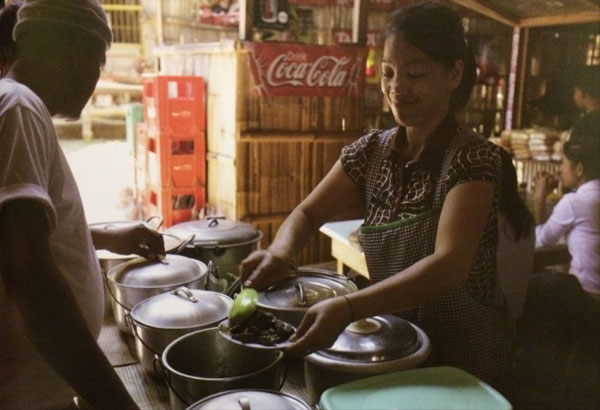Holding up half the sky: the plight of rural women

Elderly B’laan woman from South Cotabato. Jacob Maentz
In the wake of the rather unfortunate LP twerking incident recently, there has been much hue and cry about sexism and the status of women in this country. To be sure, the public is right to be scandalized. But the bigger scandal, to my mind, has to do with the overarching structures of patriarchy in this country—the deliberate obstructions preventing the full implementation of the RH law, the continuing discrimination and violence against women, the wide wage gap, and unequal access to resources and opportunities between male and female workers, which affect poor women in this country, above all.
What is particularly interesting about women in the Philippines is that, in terms of the Gender Empowerment Index, we rate very highly: that is, our women are political leaders in the legislative, executive and judiciary, not to mention in the corporate world, and are better represented than in many other parts of the world. In contrast, in terms of the Gender Development Index, poor Filipinas don’t fare well at all, since the poorest 20% has double the birth rate of the national average as a whole. What this means is that there is a very big difference in terms of social class when it comes to women: middle- and upper-class women fare well relative to their male counterparts, while poor women—especially those in rural areas--experience widespread structural discrimination. Considering that our rich resources are found primarily on our land and in our waters , we should pay particular attention to our rural women—the second largest sector for women’s employment in the country.
Recently, the United Nations (UN) declared October 15, 2015 to be International Day of Rural Women. Today, the latter make up over a quarter of the total world population. In developing nations like ours, the majority of them depend on natural resources and agriculture for their livelihoods and represent approximately 43 percent of the agricultural labor force.
In celebrating rural women, the UN gives recognition to a segment of the population that—among many other things—produces, processes and prepares much of our available food, giving them primary responsibility for food security. Likewise, the celebration hopes to raise people’s consciousness on the role and plight of rural women so that governments, business and the population at large may help empower them.
The Pambansang Koalisyon ng Kababaihan sa Kanayunan (PKKK)—or National Coalition of Rural Women—in collaboration with other rural women-based civil society organizations, emphasizes that rural women vary from one another according to how they subsist, where they are, what relationships they are in, what opportunities they have access to, and what decisions they are able to make.
A woman fisher copes differently from a woman farmer; a woman upland farmer copes differently from one in the lowlands; and indigenous women vary in beliefs and actions according to their community’s cultural, economic and political systems. But rural women share many common experiences: dependence on natural resources, seasonality of work, food provisioning roles in the family, unequal and unjust wage, and, sadly, extreme marginalization and invisibility in government policies on rural development. A fitting part of our celebration of Rural Women’s day would be to examine these distinctions. Exactly who are these rural women and what are their respective situations?
Women farmers

Woman farmer harvesting rice in Banaue, Ifugao. Al Benavente
Women farmers—women in agriculture—spend as many as eleven hours a day in productive work, like acquiring farming capital (usually through credit), carrying out planting activities, marketing the primary crop and backyard produce, and providing for their household’s daily survival needs. They spend from one to six hours daily on domestic agricultural activities like preparing farm tools and food for farm laborers; fetching water; gardening; foraging; wood gathering; raising poultry and caring for livestock. During the off-season, these women spend more time on domestic chores, as well as augmenting cash income and ensuring food for their households.
Most of these women—despite marginal access to resources and services—also exercise sole decision-making over what food to prepare for their family households. In spite of their primary role in family food security, very few of them have access to production services. Less than one-fourth has access to seeds, calamity assistance, training and extension services. Less than a tenth has access to production capital. Today, providing three meals a day for their families remains one of their top aspirations.
Women fishers

Women fishers in Camarines Norte, Bicol. BFAR
In multiple hook-and-line fishing, women contribute about 60% of the work done in the different fishing stages, such as drying and selling fish. In addition to work in fishing, women fishers perform 90% of the household work—which remains largely unremunerated. Fetching water—a responsibility presumably shared by a household’s men and women—the burden of poor access to clean water is mainly borne by women. In coastal areas, many are directly engaged in capture activities, assisting their husbands in fishing, salt-making, or gleaning fishery resources near shore for household food consumption or for market.
Despite such direct contributions to the fishing economy, women fishers are not included in the annual fisherfolk registration process. The prevailing view is that women’s work in fishing is merely part of their reproductive role. Likewise, government authorities responsible for the registration process may be biased toward market-oriented fishery activities, and perceive fishing to be a solely male occupation. Disregarding women’s role has had an evident impact on government interventions in the fishing economy. For instance, the proliferation of private hatcheries for bangus fry or seedlings has displaced the income of many women and children dependent on gleaning bangus fry in the wild to sell to aquaculture farms.
Women workers in the informal sector

Food vendor in Ilocos. Neal Oshima
There are approximately 26 million informal workers in the Philippines. Informal workers include: home-based workers; household helpers; vendors; construction workers; small transport owners and operators; barangay health workers; waste pickers; and certain types of service workers. These are income-insecure jobs—a majority of them held by women. Like their sisters in farming and fishing, they are adversely affected by non-recognition and under-representation, lack of access to productive resources, and poor access to social protection (social security, access to justice, and assistance related to gender-based violence.)
Also like agriculture-based workers and fishers, they are directly impacted by whatever economic or financial slump or crisis afflicts the country at any given time. Theirs is a number that is bound to increase, if trade-related shifts and global economic adjustments exacerbate the country’s unemployment situation.
Indigenous women

Matigsalug woman and child in Davao. Francisco Guerrero
Because of their ethnicity, indigenous culture, geographic location, and low access to education and health services, rural women in indigenous communities are the most marginalized of all. With increasing periods of food scarcity brought about by armed conflict and extractive industries such as mining and logging, food production in tribal communities remains at subsistence level. The Indigenous People’s Rights Act (IPRA) of 1997 offers the government a policy framework for relating and responding to indigenous community situations. More importantly, it intends to help tribes re-claim and maintain their ancestral lands.
While the IPRA Law recognizes women’s equality with men, interpretive issues remain regarding some provisions. Self-determination, in some cases, appears to conflict with women’s rights. This right to self-determination mandates preservation of, and respect for, customary laws and traditions. In certain contexts, that puts some indigenous women in dire circumstances. Customs and traditions that impede women’s full participation in the community’s development of ancestral domains include child marriage and commercialized dowry systems. Some communities permit the marriage of children under the legal age of 18 years. In fact, one in seven girls in developing countries is married before turning 15 years old.
Rural women—with their crucial role in food security, improving rural livelihoods, and the over-all well-being of their families—are to be lauded for their active role in the drive to achieve the UN’s Sustainable Development Goals (SDGs).
However, many rural women are unable to reach their full potential because of the multiple burden accorded to them by our patriarchal society. Many of them lack access to infrastructure, which in turn deprives them of opportunities to improve their status and reduce poverty and hunger. Because of this, rural women often spend more time than urban women in reproductive and household work--including time spent obtaining water and fuel, caring for children and the sick, and processing food. Poor infrastructure and services—and culturally assigned gender roles—also severely limit women’s participation in employment opportunities. Moreover, the wide wage gap between men and women workers put women at a disadvantage. In fact, the wage gap in forestry, fishery, and farm work stands at 13%; in trade it stands at 26%; while in service and market sales work, it stands at a high 34%.
Worldwide, illiteracy is also a major concern. Many of the world’s illiterate are rural women. Of the world’s 796 million illiterate people, two-thirds are women—many of them living in rural areas. In some countries, far fewer rural women can read and write than rural men. More importantly, rural women need to be trained to do business, becoming active entrepreneurs rather than passively accepting the dictates of dominant cartels.
Literacy and education are powerful tools for empowering rural women and fighting poverty and hunger. Statistically, women who are educated are more likely to be healthy, generate higher incomes, and have greater decision-making power within their households.
Though many rural women experience domestic violence, few seek services—or even have services available. Addressing persistent norms of inequitable gender power relations is critical to ensuring rural women’s empowerment and eradicating poverty. Beliefs that maintain gender-based violence and harmful traditional practices like early marriage and wife inheritance must be actively challenged if we are to provide equal protection under the law.
A 2005 World Health Organization multi-country study showed rural women reporting more experiences of physical abuse than urban women. The data, however, fails to show a clear pattern of whether more rural or urban women are accessing services to assist them in dealing with the abuse. Women may well doubt that services can offer the help they need. They may in fact fear for their children’s or their own safety if they report abuse. Accessing police, counseling or legal services is often more difficult for rural than for urban women due to lack of transport and distance to the nearest services.
But UN Secretary-General Ban Ki-moon remains unconditionally clear: “...rural women are critical to the success of almost all of the 17 UN Sustainable Development Goals,” of which poverty eradication is the first step.
So how to empower rural women? To begin with, they need greater access to extension services and technical assistance, especially farmers and fisher folk. They can only benefit from greater investments and technical education in precisely those natural resources that abound in the country, making the country more competitive in the fishing and farming industries. Reviving ship- and boat-building would not only strengthen manufacturing industries but prove a real boost to rural women. Pay equity in fisheries and other sectors also has to be rigorously scrutinized. Farm-to-market roads are critical. And, finally, no matter how you look at it, politicians would do better at investing in rural women rather than on obsessing on twerking Playgirls. Symptoms of sexism should push us towards, rather than away from, addressing the more systemic needs of women. On their lives rest so much of the future of this nation and the rest of our world.
- Latest
- Trending























